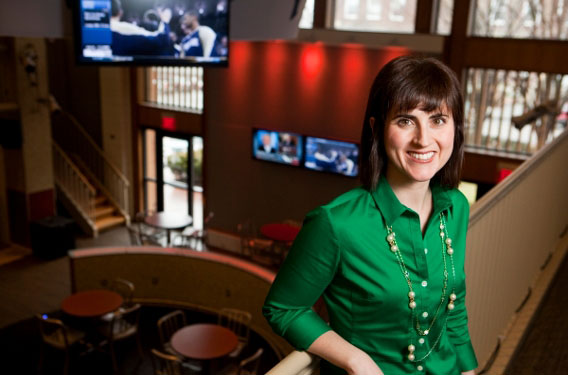No Film at Eleven
The folly of activists who court media attention
By Helene Ragovin
For sociologist Sarah Sobieraj, the “aha” moment hit in 2000, during the Republican National Convention in Philadelphia. At one point, a global justice group used human blockades to close six major traffic arteries for two hours during rush hour. Police officers in combat gear turned out, and more than 400 people were arrested.

It’s a Catch-22 for activist groups, says Sarah Sobieraj. Emphasize the emotional or personal dimension of their cause, and they get more coverage, but it’s not the kind they want. Photo: Joanie Tobin
Sobieraj, who was there to research the activities of activist groups at the convention, found herself surrounded by chaos. “I was certain this was a historic moment. I envisioned my family watching CNN as the events unfolded live and feared that they would worry,” she remembers. “Yet I soon would discover that the drama in which I was immersed had slipped completely under the radar.” The protest commanded scant media attention, and what coverage it did receive failed to mention the group’s message.
As Sobieraj came to realize, that scenario is not atypical. Contemporary activists—from all points on the political and social spectrum—are driven by the desire for media exposure and plan their strategies accordingly. But the quest for such attention usually backfires.
“Activists’ elaborate public relations efforts are largely ineffective, accrue considerable organizational costs and come at the expense of other political activities,” she writes in the introduction to her forthcoming book, Soundbitten: The Perils of Media-Centered Political Activism (NYU Press), to be published by early next year.
In their zeal to court the media, activist groups on both the right and the left have adopted the norms of political reporting. It’s an attempt to “demonstrate that they are legitimate,” says Sobieraj, an assistant professor of sociology in the School of Arts and Sciences. “They want to be taken seriously. So they prepare soundbites and hold press conferences, make press kits, to try to establish their authority through credentials.” They cite statistics. They use reasoned arguments.
What they fail to grasp, she says, is that while journalists expect such professionalism from political parties and elected officials, they want something entirely different from activists. “Instead of looking for legitimacy, journalists are looking for authenticity” from activists, Sobieraj says. “They want them to feel real.” And she goes on to explain that authenticity, from a journalist’s perspective, is signaled through amateurish behavior—“through spontaneity, being emotional, speaking off the cuff, sounding very genuine and heartfelt.”
“But there’s a Catch-22 for activist groups—if they emphasize the emotional or personal dimension” of their cause, they are a little more likely to get coverage, yet they are unlikely to get the kind of coverage they seek, she says. They end up having to choose between no coverage and coverage that’s not based on the issues.
That media-centric emphasis is counterproductive for activists in other ways as well, Sobieraj says. For example, instead of discussing politics or strategy or ideas among themselves, “groups become very focused on disciplining members so that their behavior is not embarrassing in the press, telling them what they should or shouldn’t say and how to stay on message.”
Activists’ ability to talk with bystanders on the street has also suffered as a result of their laser-like focus on making news, Sobieraj says. “The in-depth media training sessions and careful efforts to control members’ speech left many of the activists ready to offer a succinct soundbite, but quite ill-prepared to have a conversation,” she says.
When pedestrians wander up to ask questions, they often receive stilted slogans in response and are visibly put off or express confusion. “These chance urban encounters may not seem like much of a loss, but if you are an activist group whose goal is to bring your issues and perspectives to a new audience, they matter,” Sobieraj says.
Sobieraj originally didn’t expect to write a book about the relationship between activism and the media. She was interested in how “voluntary associations”—from mainstream groups like the AARP, to more radical ones such as anarchists, to all manner of social or religious movements—use presidential conventions and debates as windows of opportunity. But she was compelled to shift her focus after conducting research at the Republican and Democratic national conventions in 2000 and 2004, as well as at the presidential debates in 2000. She found that the associations attending these events were not really interested in swaying the outcome of the election.
“The election was more of a stage than a purpose,” she says. In many cases—more so in 2000 than in 2004—the activists felt little stake in the outcome of the election, or believed that neither of the main-party candidates adequately sympathized with their goals. Instead, the activists were interested in sending their message to the broader public, presumably via the media. “I was amazed, from my first outing in the field, how for organization after organization, their reason for being there was to get mainstream news attention.”
Helene Ragovin can be reached at helene.ragovin@tufts.edu.


